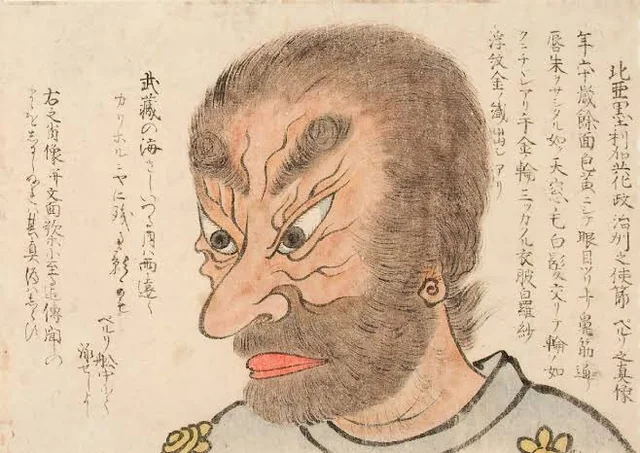D
Deleted member 3881
Just another man.
- Joined
- Nov 10, 2019
- Posts
- 3,648
- Reputation
- 6,904
Japan shows that Caucasian features aren't objectively attractive. Yes, white features are the most desired as of now so it doesn't really matter if it is objective or not but I wanted to make this thread to show that looks are heavily influenced by culture.
In Japan there is an ethnic group called the Ainu that have different ancestry (More Jomon DNA) than the typical Japanese person. These people have features found in Caucasian populations including colored eyes.



Prior to European contact, these people were considered subhuman and ugly by the Japanese and were often discriminated against. The Japanese standard for beauty in the past was what we would consider "chinky"


When Europeans first contacted the Japanese they were considered ugly (This changed pretty quickly though and they started throwing breeding parties JFL) and were drawn in a way that did not complement their features.

It was only when the Japanese realized their culture/society was inferior to the West did they start desiring European/Caucasian features. Now you see Japanese people chasing after more Caucasian features through plastic surgery. Today, many Japanese idols and celebrities have features that resemble Ainu/Jomon peoples.

If Caucasian features were objectively attractive, the Japanese would have been gunning for Ainu/Jomon genetics and features long before their contact with Europeans, but they weren't. Only after cultural exchange did they start becoming white worshipping. Now the Japanese use the Ainu/Jomon people as an example as to why they're different from other Asians.
In Japan there is an ethnic group called the Ainu that have different ancestry (More Jomon DNA) than the typical Japanese person. These people have features found in Caucasian populations including colored eyes.



Prior to European contact, these people were considered subhuman and ugly by the Japanese and were often discriminated against. The Japanese standard for beauty in the past was what we would consider "chinky"


When Europeans first contacted the Japanese they were considered ugly (This changed pretty quickly though and they started throwing breeding parties JFL) and were drawn in a way that did not complement their features.

It was only when the Japanese realized their culture/society was inferior to the West did they start desiring European/Caucasian features. Now you see Japanese people chasing after more Caucasian features through plastic surgery. Today, many Japanese idols and celebrities have features that resemble Ainu/Jomon peoples.

If Caucasian features were objectively attractive, the Japanese would have been gunning for Ainu/Jomon genetics and features long before their contact with Europeans, but they weren't. Only after cultural exchange did they start becoming white worshipping. Now the Japanese use the Ainu/Jomon people as an example as to why they're different from other Asians.
Last edited:


 How the Japanese Historically Described Ainu Appearance
How the Japanese Historically Described Ainu Appearance Primary and Secondary Sources
Primary and Secondary Sources The Ezo Soshi (蝦夷草子) — Edo-period illustrated manuscripts about the Ainu (called “Ezo” by the Japanese then) depict them with exaggerated facial and body hair, thick eyebrows, and pronounced noses. These were partly ethnographic but often caricatured, reinforcing a sense of physical and cultural otherness.
The Ezo Soshi (蝦夷草子) — Edo-period illustrated manuscripts about the Ainu (called “Ezo” by the Japanese then) depict them with exaggerated facial and body hair, thick eyebrows, and pronounced noses. These were partly ethnographic but often caricatured, reinforcing a sense of physical and cultural otherness. Hayashi Razan (1583–1657) — a prominent Neo-Confucian scholar who described the Ainu as physically coarse and inferior in his writings about Japan’s northern territories. He framed their appearance as a sign of both moral and civilizational inferiority.
Hayashi Razan (1583–1657) — a prominent Neo-Confucian scholar who described the Ainu as physically coarse and inferior in his writings about Japan’s northern territories. He framed their appearance as a sign of both moral and civilizational inferiority. Donald Keene, in Travelers of a Hundred Ages (1999) — compiles Edo-period travel accounts, including those of Japanese emissaries to Ezochi (Ainu lands), many of whom describe Ainu men and women as hairy, wild-looking, and aesthetically unpleasant by Japanese standards.
Donald Keene, in Travelers of a Hundred Ages (1999) — compiles Edo-period travel accounts, including those of Japanese emissaries to Ezochi (Ainu lands), many of whom describe Ainu men and women as hairy, wild-looking, and aesthetically unpleasant by Japanese standards. Richard Siddle’s Race, Resistance and the Ainu of Japan (1996) — a modern academic work analyzing how Japanese perceptions of the Ainu's physical appearance were historically weaponized to justify colonization and assimilation, noting that Ainu men’s beards and women’s tattooed mouths were key markers of perceived unattractiveness.
Richard Siddle’s Race, Resistance and the Ainu of Japan (1996) — a modern academic work analyzing how Japanese perceptions of the Ainu's physical appearance were historically weaponized to justify colonization and assimilation, noting that Ainu men’s beards and women’s tattooed mouths were key markers of perceived unattractiveness.